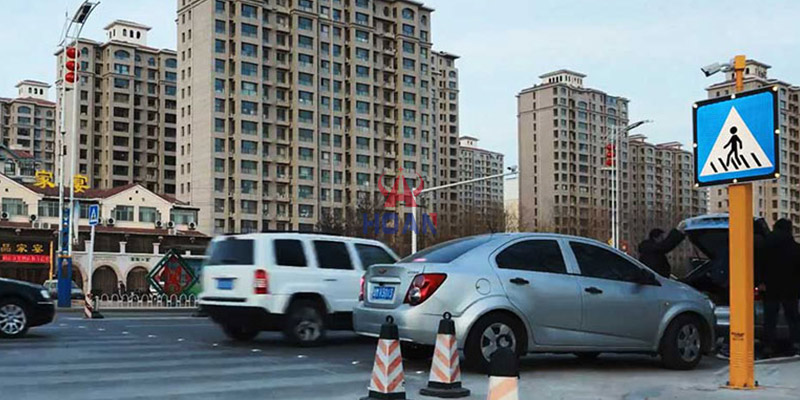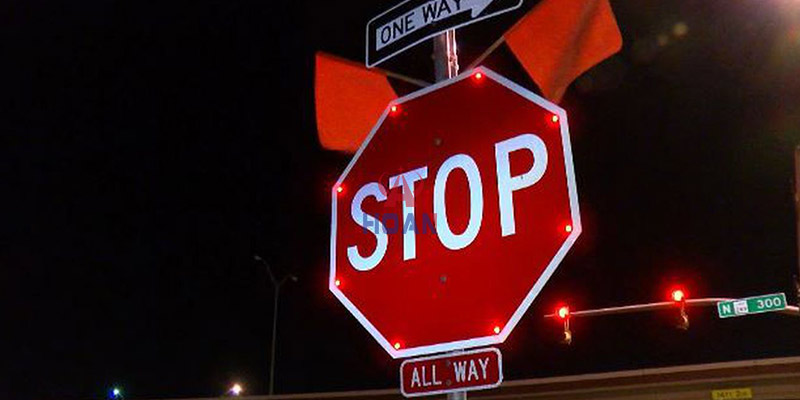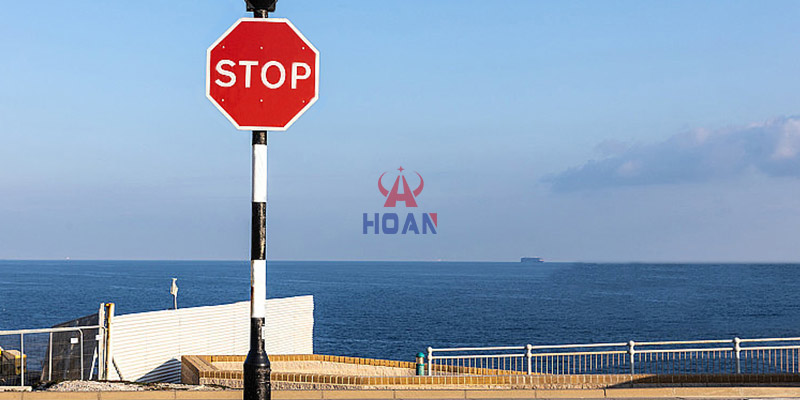In modern traffic systems, traffic signs are important facilities for ensuring road safety, regulating traffic order, and guiding drivers and pedestrians. From arrow signs indicating road directions to warning signs alerting drivers to dangerous sections of road, each traffic sign silently conveys critical information. With advancements in technology, traffic sign technology is also constantly evolving, moving toward more sustainable and intelligent solutions. Among these, solar-powered traffic signs, with their unique advantages, are gradually emerging as an efficient and environmentally friendly alternative to traditional traffic signs, attracting significant attention.
Solar-powered traffic signs primarily consist of four main components: solar panels, rechargeable batteries, LED lights, and sign panels. Solar panels serve as the ‘energy source’ of the sign, responsible for absorbing solar energy; rechargeable batteries act as the ‘energy storage unit,’ storing the electricity converted by the solar panels; LED lights function as the ‘lighting core,’ emitting bright light using the stored electricity; and the sign panels are printed or painted with various traffic information patterns and text.
During the day, the solar panels continuously absorb sunlight and convert it into electrical energy through the photovoltaic effect. This electrical energy is promptly stored in the rechargeable batteries. When night falls or in situations with insufficient light or adverse weather conditions, the stored electrical energy is released to power the LED lights. Once the LED lights illuminate, they clearly display the traffic information on the signboard, ensuring that drivers and pedestrians can clearly identify it even in low-light environments.

Solar traffic signs utilise renewable solar energy, completely eliminating reliance on traditional power grids and achieving true zero-carbon emissions. Compared to traditional traffic signs, they do not consume large amounts of electrical resources, not only saving users long-term electricity costs but also significantly reducing energy consumption and environmental pollution, thereby effectively promoting the development of green transportation.
Solar-powered traffic signs are equipped with LED lights, which feature high brightness and uniform lighting. Whether in severe weather conditions such as heavy rain or dense fog, or during pitch-black nights, they remain clearly visible. This high visibility enables drivers and pedestrians to promptly and accurately obtain traffic guidance information, effectively preventing misjudgments and accidents caused by poor visibility, and significantly enhancing road traffic safety levels.
Maintenance of solar-powered traffic signs is extremely straightforward. Routine maintenance involves occasional cleaning of dust, leaves, and other debris from the solar panel surface, along with regular checks of battery status. Since there is no need for complex electrical wiring or frequent bulb replacements, maintenance costs are significantly reduced. In the long term, this not only saves on maintenance expenses but also minimises replacement costs due to equipment failures, resulting in overall cost-effectiveness far surpassing that of traditional traffic signs.

On highways and expressways, solar-powered traffic signs are widely used to display speed limit information, lane control instructions, and warnings about upcoming exits, curves, construction zones, and other hazards. For example, solar-powered speed limit signs are installed on long downhill sections to remind drivers to control their speed, while solar-powered warning signs are deployed around construction zones to guide vehicles to safely detour.
In urban roads, solar-powered traffic signs play a crucial role in managing traffic flow. Common signs such as stop signs, yield signs, one-way signs, and pedestrian crossing signs ensure orderly urban traffic operations. Especially in narrow alleys with insufficient lighting at night, the high visibility advantage of solar-powered signs is particularly prominent.
On rural roads, solar-powered traffic signs are crucial for ensuring traffic safety. They clearly indicate hazardous sections such as sharp curves, animal crossing zones, and low-clearance bridges, reminding drivers to exercise caution and providing safety protection for rural residents and passing vehicles.
For construction sites, solar-powered traffic signs are an ideal choice. They are flexible to install and easy to move, providing clear warnings and guidance for temporary detours, speed-limited zones, and construction areas. In scenarios such as large-scale events, festivals, or road closures requiring temporary traffic management, solar-powered signs can be quickly deployed and adjusted in real-time to meet specific needs, efficiently completing traffic diversion tasks.
In parking lots, solar-powered signs are used to clearly mark restricted parking areas, such as no-parking zones and time-limited parking zones. They also guide drivers to available parking spaces and indicate the locations of disabled parking spaces, enhancing the management efficiency and convenience of parking lots.
In pedestrian activity areas, solar-powered traffic signs are used to mark crosswalks and pedestrian-only zones, as well as to warn of safety hazards such as uneven road surfaces or low-hanging branches, ensuring the safety and comfort of pedestrians.
In railway systems, solar-powered signs can be used for warnings near railway crossings, alerting passing vehicles and pedestrians to train movements; they can also display track condition information to guide railway staff.
At airports, solar-powered signs are used for runway markings, taxiway indicators, and guiding aircraft to parking bays or service facilities, playing an indispensable role in ensuring airport ground traffic order and flight safety.

Under low-light or adverse weather conditions, the visibility of traditional non-illuminated traffic signs is significantly reduced, potentially leading to accidents due to drivers struggling to discern sign information. In contrast, solar-powered traffic signs maintain clear visibility at all times thanks to the continuous illumination of LED lights, offering a clear performance advantage. Compared to traditional electric traffic signs, solar-powered signs eliminate the risk of sign failure due to power outages, ensuring higher stability.
From a cost perspective, while the initial procurement cost of solar-powered traffic signs may be slightly higher than that of traditional signs, traditional signs incur high electricity costs and frequent maintenance expenses over the long term. Solar-powered signs, powered by solar energy and requiring minimal maintenance, offer greater economic efficiency in terms of long-term usage costs.
Solar-powered traffic signs have become an essential tool for modern traffic management and road safety. For traffic planners, engineering contractors, and government departments, it is advisable to prioritise solar-powered traffic signs in traffic facility construction and renovation projects. For more product information or customised solutions, please feel free to contact us to jointly promote the development of smart transportation.